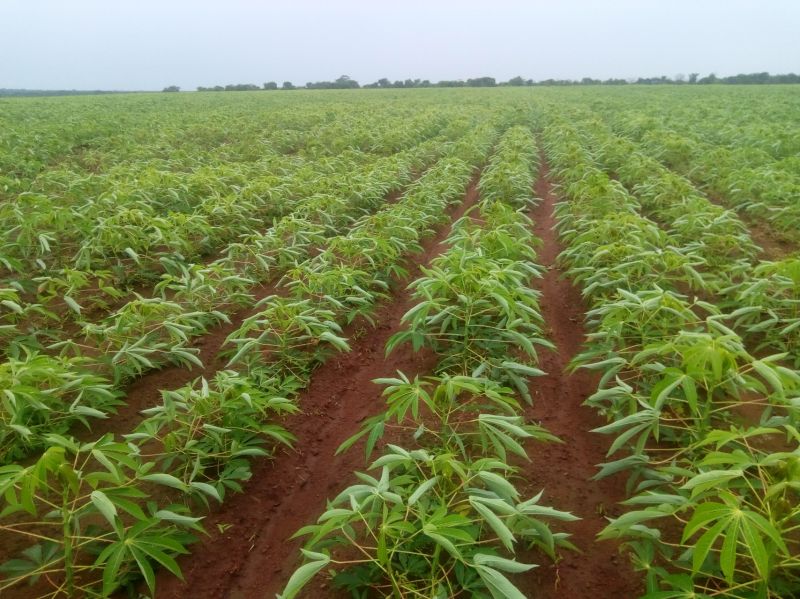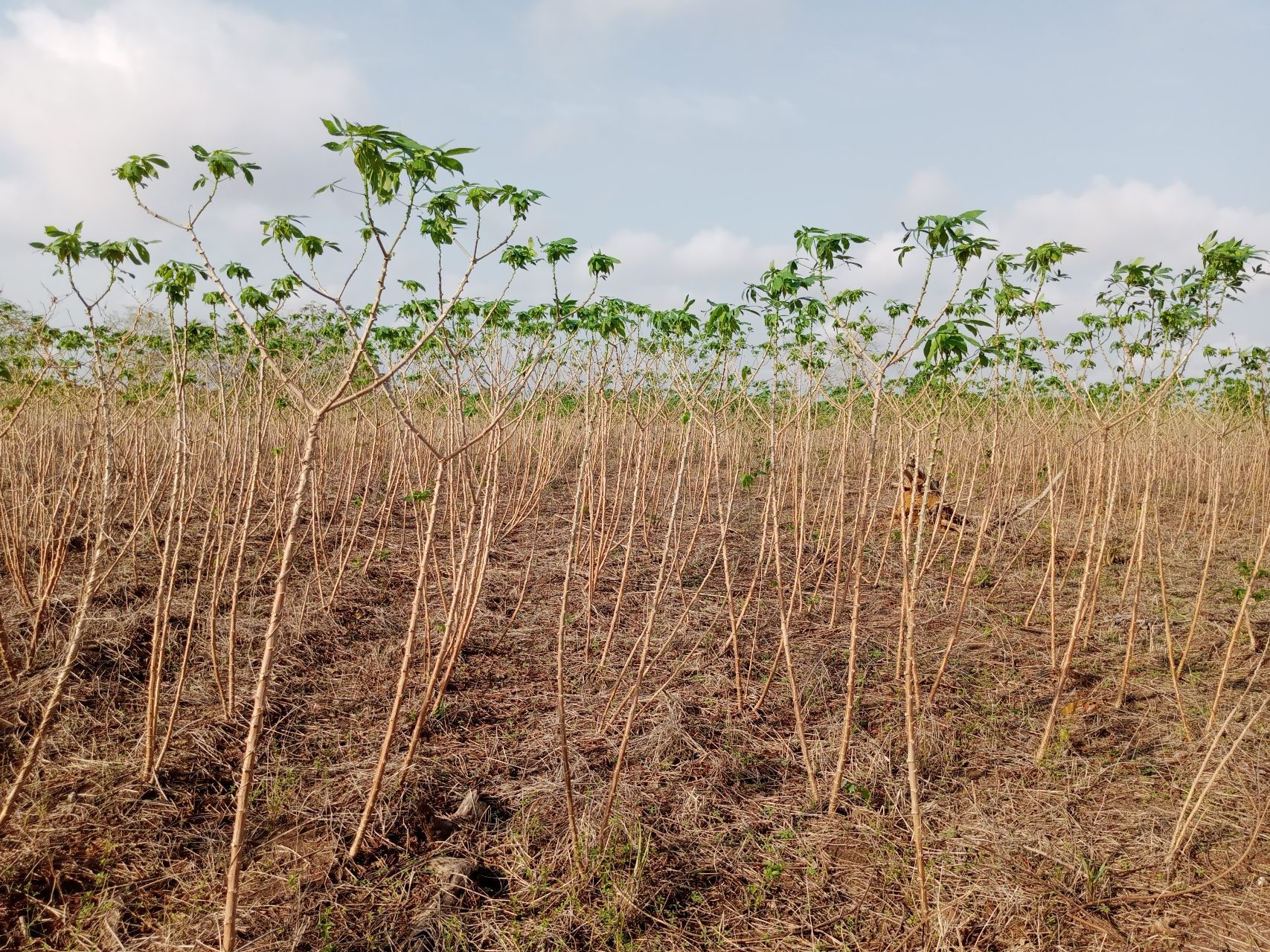Cassava: History, Nutritional Value, and Plant Information

This post is also available in:
This post is also available in:
![]() Français (French)
Français (French) ![]() Deutsch (German)
Deutsch (German) ![]() Türkçe (Turkish)
Türkçe (Turkish) ![]() Ελληνικά (Greek)
Ελληνικά (Greek)
History of Cassava
The origin of cassava can be traced to South America, the Cerrado, in present-day Brazil. Cassava was first domesticated in West-Central Brazil around 10,000 years ago (1,2,3). Today it is cultivated in tropical regions worldwide and is the sixth most important crop plant worldwide (4,5.6). Cassava is a drought-tolerant crop that can survive hot climates with little rainfall. The plant can be grown throughout the year under severe climates of marginal soils of low nutrients (2-4). Today, cassava is used as a staple food in different parts of the world and for food security. Millions of farmers around the world make a living from cultivating this crop (7,8,9)
There are two types of cassava varieties, namely, sweet and bitter cassava varieties. The sole difference between the two cassava varieties is the number of cyanide compounds they produce (3-6). Though both varieties are cultivated in the same way, the bitter variety produces a higher amount of cyanide compounds in the cassava tubers than the sweet variety (10, 11,12). For instance, sweet cassava varieties may contain as few as 40 parts per million (ppm) cyanide compounds in cassava tubers. It does not require much processing before it is safe to eat, making it less poisonous. The cassava tubers are only safe to eat when cyanide compounds are removed from the tubers (4, 5,6,7, 8)
Bitter cassava varieties contained over 50 parts per million (ppm) cyanide compounds. Research shows that bitter cassava varieties contain high as 490 parts per million (ppm) cyanide compounds (5,8,7). It has been documented that any quantity over 50 parts of cyanogens per million is said to be harmful and unsafe for consumption (1,2,3,4). Cyanide compounds present in cassava constitute a huge threat to health and can even cause death if the cyanide compounds are not processed before consumption (5,7,9). Several methods can be applied to process cyanide compounds from cassava. Namely, drying, soaking, boiling, and roasting. While drying reduces the level of cyanide, it does not remove it from cassava, making it not adequately safe for consumption. The other methods can reduce the cyanide content to manageable levels for safe consumption (10,11,12).

Nutritional value of cassava
The consumption of cassava comes with significant nutritional benefits, and every part of the plant can serve as food for humans and animals. Cassava is rich in nutrients such as it is rich in calcium, vitamins A, B, and C, and essential minerals such as thiamine, folic acid, iron, manganese, potassium, and Zinc (1,2,3,4,5,6,7) and is a major source of carbohydrates (it gives carbohydrate production about 40% higher than rice and 25% higher than maize (4,5,6,7,9)). Cassava is becoming increasingly popular among African farmers because of its agricultural advantages and potential to feed the rapidly increasing populations. (1,2,3,4). Next to Brazil and Indonesia, Nigeria is the third-largest producer of cassava and the largest producer in Africa (3,4,9,10,11). Cassava tubers are the most consumed plant part. It can be served as food as a potato mashed or made into starchy cakes or even bread. Cooked cassava leaves are served as food and are an essential ingredient in soups and stews in parts of Central Africa, and humans consume the leaves for medicinal purposes (1,2,3,5,7,9).

Cassava Plant Information
Cassava (Manihot esculenta), also called manioc, mandioca, or yuca, is a tuberous edible, slightly woody, and shrubby plant belonging to the spurge family (Euphorbiaceae) that typically grows from one to three meters (3-10 feet) in height (1, 2,3).
It is a perennial plant, and it is characterized by fan-lobed leaves, starchy, tuberous roots, papery brown bark, and white to yellow flesh (2,3,4,9). The cassava root is long, about 1 mm thick, with rough and brown skin.
There are different varieties of cassava, from low herbs to branching shrubs. Some of these varieties are adapted to acid mud banks along rivers, and others are dry areas of alkaline soil. The chemical compounds (cyanogenic glucosides) in the roots and leaves of cassava offer some protection against some herbivores animals. This chemical compound can be toxic to humans if consumed without treatment and processing.
Because cassava can survive and grow in non-humid environments, it is replacing some other root crops, such as yam, which require higher soil fertility to grow and are easily infested with pests (5,7,11,9,10). Except for sugarcane, the cassava plant gives the highest yield of food energy among crop plants per cultivated area daily (2, 3, 4, 8, 9).
Cassava is grown by cutting a mature stem into sections 15 centimetres (6 inches). The planting of cassava planting requires adequate moisture during the first two to three months. Usually, planting takes place during the wet season. (1,2,3,4). However, the plants are drought resistant. The roots are a very popular food and are harvestable after six to twelve months (1,2). Cassava is harvested by hand. This is done by raising the lower part of the stem and pulling the roots out of the ground (4,5,6). After harvesting, it is either consumed immediately or processed into a form with better storage qualities. Because it takes three to five days to decay (6,5,9). Cassava roots can be stored in the ground for as long as 24 months.
References
- Weaver, W. (2003) Peas. In: Katz, S.H., Ed., Vols. 1-3, Encyclopedia of Food and Culture, Charles Scribner & Sons, New York.
- Asogwa I.S., Okoye J.I, Oni K. 2017. Promotion of Indigenous Food Preservation and Processing Knowledge and the Challenge of Food Security in Africa. Journal of Food Security.; 5(3):75-87. doi: 10.12691/jfs-5-3-3.
- Food and Agricultural Organization (FAO). 2001,2003. FAO/GIEWS-Food Outlook No. 4 Oct. 2001; FAO/GIEWS-Food Outlook No. 4, Oct 2003.
- Ngoc Quyen and Hernan Ceballos. 2002. Genetic improvement of cassava in Vietnam: Current status and future approaches. In: R.H. Howeler (Ed.). Cassava Research and Development in Asia: Exploring New Opportunities for an Ancient Crop. Proc. 7th Regional Cassava Workshop, held in Bangkok, Thailand. Oct 28-Nov 1, 2002. http://www.ciat.cgiar.org/asia_cassava (in preparation)
- Le Van An, Hoang Thi Sen, Nguyen Xuan Hong, Hoang Huu Hoa, Le Quang Bao, Nguyen Thi Cach,
- Nguyen Thi My Van and Peter Kerridge. 2002. Use of participatory approaches in ensuring sustainable livelihoods for poor communities in the steep uplands of Central Vietnam. In: R.H. Howeler (Ed.).
- Cassava Research and Development in Asia: Exploring New Opportunities for an Ancient Crop. Proc. 7th Regional Cassava Workshop, held in Bangkok, Thailand. Oct 28-Nov 1, 2002 http://www.ciat.cgiar.org/asia_cassava. (in preparation)
- Ngo Ke Suong and Hoang Kim Anh. 2001. The hydrolysis of cassava starch by amylase enzyme for alcohol production. In: VNCP-IAS-CIAT-VEDAN. Hoang Kim and Nguyen Dang Mai (Eds.) Progress in Cassava
- Nguyen The Dang. 2002. Farmer participatory research (FPR) on the soil erosion control and fertilizer use for cassava in Vietnam. In: R.H. Howeler (Ed.). Cassava Research and Development in Asia: Exploring New9 Opportunities for an Ancient Crop. Proc. 7th Regional Cassava Workshop, held in Bangkok, Thailand. Oct 28-Nov 1, 2002. http://www.ciat.cgiar.org/asia_cassava (in preparation)
- Pham Sy Tiep. 2001. The effect of different processing methods on the chemical contents and nutritional values of cassava leaves and roots. In: VNCP-IAS-CIAT-VEDAN. Hoang Kim and Nguyen Dang Mai (Eds.). Progress in Cassava Research and Extension in Vietnam. Proc. 10th Vietnamese Cassava Workshop, held March 13-14, 2001 in IAS, Ho Chi Minh City, Vietnam. pp. 167-171. (in Vietnamese with English Summary)
- Pham Van Bien, Hoang Kim, Joel J. Wang and R.H. Howeler. 2001. Present situation of cassava production and the research and development strategy in Vietnam. In: R.H. Howeler and S.L.Tan (Eds.). Cassava’s Potential in the 21st Century: Present Situation and Future Research and Development Needs. Proc. 6th
- Tran Thi Dung and Nguyen Thi Sam. 2002. FPR trials on cassava intercropping systems in Vietnam. In: R.H. Howeler (Ed.). Cassava Research and Development in Asia: Exploring New Opportunities for an Ancient Crop. Proc. 7th Regional Cassava Workshop, held in Bangkok, Thailand. Oct 28-Nov 1, 2002. http://www.ciat.cgiar.org/asia_cassava
- Cassava: History, Nutritional Value, and Plant Information
- Cassava Climate and Soil Requirements
- Cassava Varieties
- Cassava Propagation and Planting
- Cassavas Weed Management and Control
- Cassava crop Water Needs and irrigation Systems
- Cassava Fertilization Requirements
- Pruning of Cassava plants
- Major Pests and Diseases of Cassava
- Cassava Harvest, Yield per hectare and Storage








































































